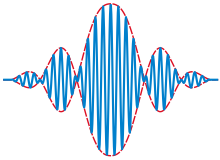Phase velocity and group velocity are two very important concepts in physics. ... The group velocity is the velocity of the wave with lower frequency, but the phase velocity is the velocity of the wave with higher frequency.
Phase Velocity
The phase velocity of a wave is the rate at which the phase of the wave propagates in space. This is the velocity at which the phase of any one frequency component of the wave travels. For such a component, any given phase of the wave (for example, the crest) will appear to travel at the phase velocity. The phase velocity is given in terms of the wavelength λ (lambda) and time period T as
Equivalently, in terms of the wave's angular frequency ω, which specifies angular change per unit of time, and wavenumber (or angular wave number) k, which represents the proportionality between the angular frequency ω and the linear speed (speed of propagation) νp,
x
To understand where this equation comes from, consider a basic sine wave, A cos (kx−ωt). After time t, the source has produced ωt/2π = ft oscillations. After the same time, the initial wave front has propagated away from the source through space to the distance x to fit the same number of oscillations, kx = ωt.
Thus the propagation velocity v is v = x/t = ω/k. The wave propagates faster when higher frequency oscillations are distributed less densely in space.[2] Formally, Φ = kx−ωt is the phase. Since ω = −dΦ/dt and k = +dΦ/dx, the wave velocity is v = dx/dt = ω/k.
Group velocity
The group velocity of a wave is the velocity with which the overall envelope shape of the wave's amplitudes—known as the modulation or envelope of the wave—propagates through space.
For example, if a stone is thrown into the middle of a very still pond, a circular pattern of waves with a quiescent center appears in the water, also known as a capillary wave. The expanding ring of waves is the wave group, within which one can discern individual wavelets of differing wavelengths traveling at different speeds. The shorter waves travel faster than the group as a whole, but their amplitudes diminish as they approach the leading edge of the group. The longer waves travel more slowly, and their amplitudes diminish as they emerge from the trailing boundary of the group.
The group velocity vg is defined by the equation:
where ω is the wave's angular frequency (usually expressed in radians per second), and k is the angular wavenumber (usually expressed in radians per meter). The phase velocity is: vp = ω/k.
The function ω(k), which gives ω as a function of k, is known as the dispersion relation.
- If ω is directly proportional to k, then the group velocity is exactly equal to the phase velocity. A wave of any shape will travel undistorted at this velocity.
- If ω is a linear function of k, but not directly proportional (ω = ak + b), then the group velocity and phase velocity are different. The envelope of a wave packet (see figure on right) will travel at the group velocity, while the individual peaks and troughs within the envelope will move at the phase velocity.
- If ω is not a linear function of k, the envelope of a wave packet will become distorted as it travels. Since a wave packet contains a range of different frequencies (and hence different values of k), the group velocity ∂ω/∂k will be different for different values of k. Therefore, the envelope does not move at a single velocity, but its wavenumber components (k) move at different velocities, distorting the envelope. If the wavepacket has a narrow range of frequencies, and ω(k) is approximately linear over that narrow range, the pulse distortion will be small, in relation to the small nonlinearity. See further discussion below. For example, for deep water gravity waves, , and hence vg = vp/2.This underlies the Kelvin wake pattern for the bow wave of all ships and swimming objects. Regardless of how fast they are moving, as long as their velocity is constant, on each side the wake forms an angle of 19.47° = arcsin(1/3) with the line of travel.




